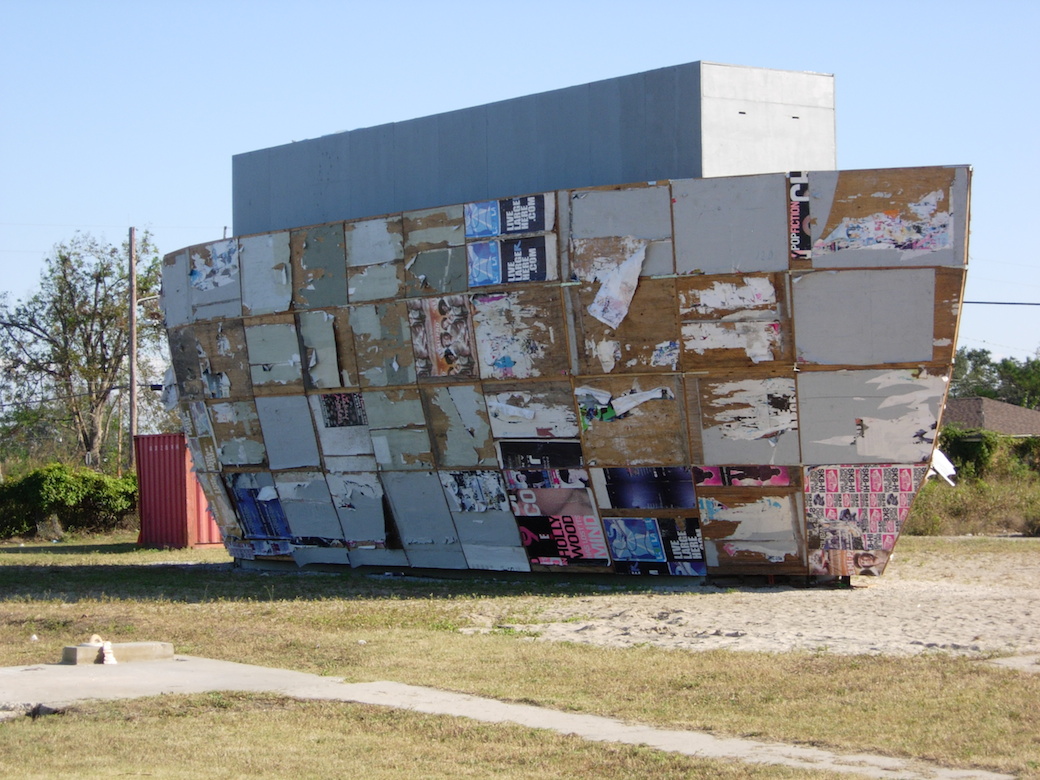
Mark Bradford. Mithra, 2008. Installation view: Prospect.1 New Orleans. Mixed media; 16 x 70 feet. Photo: Nicole J. Caruth.
Mark Bradford transforms maps, blueprints, and everyday materials—including merchant posters, flyers, and advertisements—into large-scale paintings, installations, and sculptures using a range of media such as collage, decoupage, film, and photography. Bradford describes himself as a maker and an excavator, a speculator and a developer, a demolisher and a builder. On the occasion of ART21’s new film featuring artists in the Prospect.3 New Orleans biennial, we look back to Bradford’s keynote address for ART21 at the 2009 National Art Education Association (NAEA) conference, in which the artist discussed his 70-foot-high ark Mithra (2008) that he made for Prospect.1, largely in response to the tragedy of Hurricane Katrina. (This transcript has been edited for clarity.)
Minneapolis Convention Center, Minneapolis, MN, April 2009
“Dan Cameron [the founding director and curator of the biennial] invited artists from all over the world to come down and to do projects for Prospect.1. Initially, it was very exciting to go to a biennial, but because of the recent history in New Orleans, it was very difficult. I went there, and I was absolutely devastated. I mean, this was just a year ago. All the empty lots that you saw had been homes… It was emotional for me, and I didn’t really know how to start. You have to be so careful when you’re in other people’s homes.
I ended up building an ark in the Lower Ninth Ward, but I am going to go back to the beginning, of how I was even able to do this project. When I was first going to New Orleans, I had an idea for a project, but I was so dismayed by what was going on that I did not know how to even take pictures. I didn’t know how to document the experience. I didn’t want to disrespect the recent histories.
I knew that I wanted to build a large vessel, and this FEMA sign that reads “1 Cat Seen” kind of got me going. Every house in New Orleans had to be inspected for survivors. I decided to concentrate on the animals because in some houses, it would have five or six dead people, and I didn’t want to document that. This sign was “1 Cat Seen,” and I started thinking about one cat instead of two, about Noah’s ark, about where the other cat would be, and about isolation and wandering. So that is one element of the project: “1 Cat Outside.” “Beagle Taken.” “Both Canines Rescued.” “Shepherd Seen.” I also used the billboards that I use in my painting practice as the structure for the ark.

Gardening work local youth at L-9.
When I was wandering around in New Orleans, I came across Keith Calhoun, who was a photographer and had lost everything. The picture of Keith and me shows the site of his home: it was completely destroyed by Hurricane Katrina. Well, Keith got enough money together to buy a very small shotgun house. Instead of taking the money and building a home for him and his family, he [and his wife Chandra McCormick] built a nonprofit. I don’t know if I could have done that, if I had lost everything. But he believed that art was the way to rebuild the Lower Ninth Ward. When I met him I thought, “Okay, I’ll work with him. I will commit myself to working with him to raise money to rebuild.” The nonprofit was called L9 Center for the Arts. Over the course of a year, we raised money and had an auction. I auctioned one of my larger works, we raised about $125,000, and their operation began. They were able to have a show.
Once L9, the only nonprofit that was in the Lower Ninth Ward, got up and running, I felt like I could start to build the sort of sculpture I was thinking about. It was built around shipping containers. It was 70 feet long by 16 feet high. I’m scared of heights, so I don’t know how I did it.
I hosted a crab boil for the whole Lower Ninth Ward, and it was the first time that children played in that part of the neighborhood since the hurricane. The whole community came out, and it was a renewing experience. It was quite beautiful that day.
We all live somewhere, and we all belong to a community: Learn to partner with people in your communities. I’m not just talking about other cultural institutions. I’m talking about the local grocer, and I’m talking about the local diner. If you have galleries in your community, you can call them up and you can say, “Listen, my kids have just finished a fantastic collaboration, and on a Sunday you need to open your doors and let us put it up and have some fancy wine and cheese.” Why not? At the shoe store, demand collaborations with the people where you spend money. You spend money there. If we don’t ask for something, we’ll never know if it might be given. I got lost in the Lower Ninth Ward, and Keith Calhoun was working on this nonprofit, and I just walked in and said, “Well I don’t know what you do, but I’m an artist and I think we can work together.” He looked me up and down and said, “What? Really?”
I would have never known unless I had put myself in a vulnerable position and stepped outside of my comfort zone.”




Pingback: Mark Bradford on Prospect.1 New Orleans - 1-954-270-7404
Pingback: Mark Bradford Will Rep The United States At The 2017 Venice Biennale | ARTnews